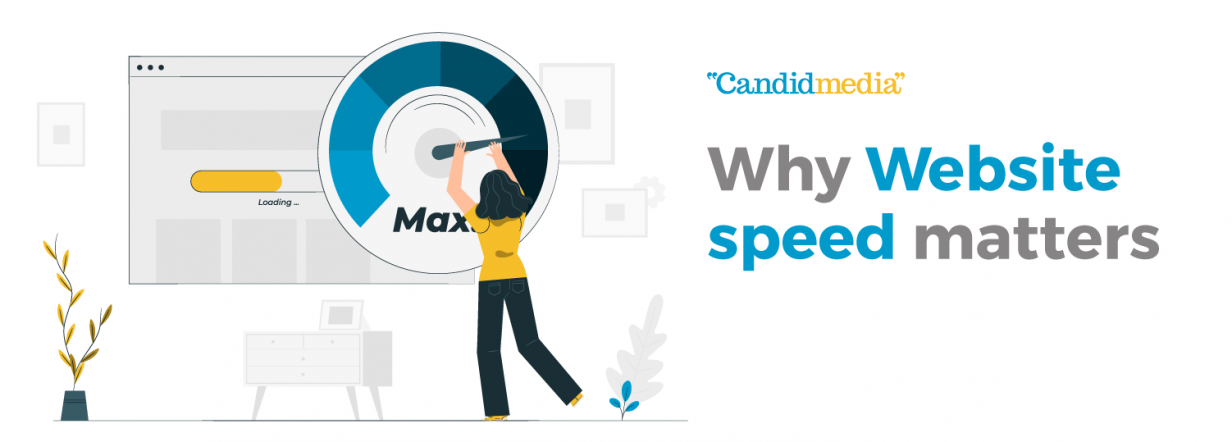Capabilities
We personify your brand to build quantifiable connect.
Strategy
Define and capitalize your business goals by creating the best process and digital strategies to transform your brand.
View all

 May 17 | 2021
May 17 | 2021
When it comes to maximizing online conversions, website speed matters! It is also important to understand key metrics about page speed and how it has a significant impact on Google core vitals. A website that is optimized for speed and page relevance doesn’t only enhance the user experience (UX) but also influences page ranking.
To put this into perspective, a 1-second delay in page-load-time yields a 7% loss in conversion. It is a conversion killer. How long will you able to run your business while losing leads?
Let’s understand Page speed and why it is important.
Page Speed
Page Speed indicates the loading time of a specific landing page. It is determined by several factors, including a site's server, page file size, and image compression. There are different ways of measuring and below are the four common ways to determine page speed:
Why Page Speed is important for Search Engine Optimization ( SEO)
Page speed is an important ranking signal for both desktop and mobile searches. The delay in page load often triggers a negative perception of your brand’s product and service offerings. To reduce your bounce rate and increase visitor engagement it is important that your website loads quickly and seamlessly.
Page speed also plays a pivotal role in Search Engine Optimization (SEO). Google takes a wide variety of factors into consideration when deciding how to rank web pages. Speed is an important ranking signal for both desktop and mobile searches.
How to test your website speed?
There are a lot of free and paid website speed test and performance monitoring tools that you can use like Pingdom and GTmetrics which are great beginner tools to assess your current website speed. Webpagetest.org is another cool tool you can use to get a detailed page load time in a waterfall view.
Google PageSpeed Insights gives you website performance reports for both mobile and desktop views. As a Google-supported tool, it can help you make sure you're hitting the performance benchmarks required for high search result placements. For non-developer users, this it may be slightly intimidating in the beginning but it offers tangible action points for each issue to optimize the website speed.
It is always advisable to test your website speed performance with 2-3 tools and run multiple tests to be thorough only to provide a faster and consistent user experience on your website.
5 quick steps to improve Page Loading Speed
Get rid of unnecessary plug-ins: Having unnecessary plugins slows down your site. It is always better to review all your existing plug-ins and their functionalities. There might be some that are either overlapping or simply no longer relevant to your needs. Deactivate all the plugins and test them out one by one using PageSpeed Insight to if scores or timings have been impacted.
Cache those web pages: Caching lowers Time to First Byte (TTFB) and hence it is an effective way to speed up your webpages. There are multiple ways to cache your website. You can either do this at a server level or use a free caching plugin like W3 Total Cache for WordPress websites. Browser caching is another way of caching where the browser stores resource information and doesn’t have to reload the page every time a user visits it.
Enable Compression: Images enhance the visual experience of a landing page but it also delays the loading time. It is important to compress and optimize your image by changing file format or through lossless compression.
Reduce Redirects: Every time a user is redirected to another landing page, it increases the HTTPS request and response process. Some redirects may be important but eliminating duplicate and unnecessary redirects on your site can result in slower page loading times.
Use Content Distribution Network (CDN): A content delivery network (CDN) refers to a geographically distributed group of servers that work together to provide fast delivery of Internet content. A CDN allows for the quick transfer of assets which is essential to load internet content including HTML pages, javascript files, stylesheets, images, and videos. Today, major website traffic is served through CDN services including traffic from websites like Netflix, Amazon, and Facebook.